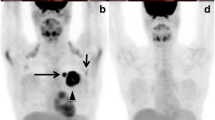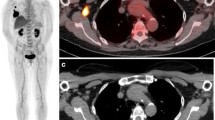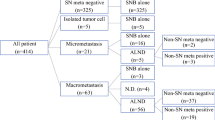Abstract
Seventeen patients with advanced breast cancer were imaged with a specially collimated gamma camera to study tumor uptake of 2-[18F]-fluoro-2-deoxy-D-glucose (FDG) before and during therapy. Fourteen patients (82%) showed increased FDG accumulation in metastatic tumors, 6/8 (75%) of axillary, supra or infraclavicular metastatic lymph nodes were detectable. In one of these cases, FDG imaging was the first method to identify axillary metastasis causing nerve compression. Also, pulmonary and liver metastases could be imaged with FDG; both in two patients. The intra individual variability in uptake was considerable in bone metastases, and some lesions remained FDG negative:99mTc-DPD was superior in detecting bone disease. Bone metastases of the osteolytic or mixed type were better visualized than sclerotic ones. Ten patients were reimaged later to assess the effect of therapy on FDG uptake. Increased uptake was associated with clinical progression, while unchanged or diminished uptake did not predict the course of disease as reliably. This study indicates that FDG can be used to image breast cancer metastases. FDG may be valuable in monitoring treatment response, but positron emission tomography (PET) would probably be more appropriate than planar imaging for this purpose.
Similar content being viewed by others
References
Abe Y, Matsuzawa T, Fujiwara T, Fukuda H, Itoh M, Yamada K, Yamaguchi K, Sato T, Ido T (1986) Assessment of radiotherapeutic effects on experimental tumors using18F-2-fluoro-2-deoxy-D-glucose. Eur J Nucl Med 12:325–328
Ahonen A, Paul R, Aho A, Dean P, Roeda D, Solin O, Virtama P, Ekfors T, Nordman E, Haaparanta M, Wegelius U (1986) Differential diagnosis of bone tumors using fluorodeoxyglucose and three phase99mTc-DPD scanning. In: Schmidt HAE, Ell PJ, Britton KE (eds) Nuclearmedizin. Proc. ENMC. Schattauer, Stuttgart New York, pp 441–443
d'Argy R, Paul R, Frankenberg L, Stålnacke CG, Lundqvist H, Kangas L, Halldin C, Någren K, Roeda D, Haaparanta M, Solin O, Långström B (1988) Comparative double-tracer wholebody autoradiography: uptake of11C-,18F-, and3H-labeled compounds in rat tumors. Int J Nucl Med Biol 15:577–585
Beaney RP, Lammertsma AA, Jones T, McKenzie CG, Halnan KE (1984) Positron emission tomography for in-vivo measurement of regional blood flow, oxygen utilisation, and blood volume in patients with breast carcinoma. Lancet 1:131–134
Bolster JM, Vaalburg W, Paans AMJ, van Dijk TH, Elsinga PH, Zijlstra JB, Piers DA, Mulder NH, Woldring MG, Wynberg H (1986) Carbon-11 labelled tyrosine to study tumor metabolism by positron emission tomography (PET). Eur J Nucl Med 12:321–324
Campbell FC, Blamey RW, Elston CW, Morris AH, Nicholson RI, Griffiths K, Haybittle JL (1981) Quantitative oestradiol receptor values in primary breast cancer and response of metastases to endocrine therapy. Lancet 2:1317–1319
Di Chiro G (1986) Positron emission tomography using [18F]fluorodeoxyglucose in brain tumors: a powerful diagnostic and prognostic tool. Invest Radiol 22:360–371
Di Chiro G, Hatazawa J, Katz DA, Rizzoli HV, De Michele DJ (1987) Glucose utilization by intracranial meningiomas as an index of tumor aggressivity and probability of recurrence: a PET study. Radiology 164:521–526
Fisher ER (1984) The impact of pathology on the biologic, diagnostic, prognostic, and therapeutic considerations in breast cancer. Surg Clin North Am 64:1073–1093
Fukuda H, Ito M, Matsuzawa T, Abe Y, Yoshioka S, Kubota K, Kiyosawa M, Hatazawa J, Ito K, Fujiwara T, Yamada K, Ido T (1983) Clinical evaluation of cancer diagnosis with18F-2-deoxy-2-fluoro (18F)-D-glucose. CYRIC annual report 1983:244–249
Gallagher BM, Fowler JS, Gutterson NI, MacGregor RR, Wan CN, Wolf AP (1978) Metabolic trapping as a principle of radiopharmaceutical design: some factors responsible for the biodistribution of (18F)2-deoxyglucose. J Nucl Med 19:1154–1161
Hayward JL, Carbone PP, Heuson JC, Kumaska S, Segaloff A, Reubens RD (1977) Assessment of response to therapy in advanced breast cancer. Cancer 39:1289–1293
Haaparanta M, Bergman J, Solin O, Roeda D (1984) A remotely controlled system for the routine synthesis of18F-2-fluoro-2-deoxy-D-glucose. Nuklearmedizin 21 [Suppl]:823–826
Harris JR, Schnitt SJ, Connolly JL, Silen W (1987) Conservative surgery and radiation therapy for early breast cancer. Arch Surg 122:754–755 (editorial)
Iosilevsky G, Front D, Bettman L, Hardoff R, Ben-Arieh Y (1985) Uptake of gallium-67 citrate and [2-3H] deoxyglucose in the tumor model, following chemotherapy and radiotherapy. J Nucl Med 26:278–282
Joensuu H, Ahonen A (1987) Imaging of metastases of thyroid carcinoma with fluorine-18 fluorodeoxyglucose. J Nucl Med 28:910–914
Minn H, Joensuu H, Ahonen A, Klemi P (1988a) Fluorodeoxyglucose imaging: a method to assess the proliferative activity of human cancer in vivo. Cancer 61:1776–1781
Minn H, Paul R, Ahonen A (1988b) Evaluation of treatment response to radiotherapy in head and neck cancer with (18F)fluorodeoxyglucose. J Nucl Med 21:1521–1525
Mintun MA, Welch MJ, Mathias CJ (1987) Application of 16α-[F-18]-fluoro-17β-estradiol (I) for the assessment of estrogen receptors in human breast carcinoma. J Nucl Med 28 [Suppl.]:561 A:19 (abstr)
Nolop KB, Rhodes CG, Brudin LH, Beaney RP, Krausz T, Jones T, Hughes JMB (1987) Glucose utilization in vivo by human pulmonary neoplasms. Cancer 60:2682–2689
Patronas NJ, DiChiro G, Brooks RA, DeLaPaz RL Kornblith PL, Smith HH, Rizzoli HV, Kessler RM, Manning RG, Channing M, Wolf AP, O'Connor CM (1982) Work in progress:18F fluorodeoxyglucose and emission tomography in the evaluation of radiation necrosis of the brain. Radiology 144:885–889
Paul R, Roeda D, Johansson R, Ahonen A, Haaparanta M, Solin O, Sipilä H (1986) Scintigraphy with [18F]2-fluoro-2-deoxy-D-glucose of cancer patients. Int J Nucl Med Biol 13:7–12
Phelps ME, Huang SC, Hoffman EJ, Selin C, Sokoloff L, Kuhl DE (1979) Tomographic measurement of local cerebral glucose metabolic rate in humans with (F-18) 2-fluoro-2-deoxy-D-glucose: validation of a method. Ann Neurol 6:371–388
Schelstraete K, Simons M, Deman J, Vermeulen FL, Slegers G, Vandecasteele C, Goethals P, De Schryver A (1982) Uptake of13N-ammonia by human tumours as studied by positron emission tomography. Br J Radiol 55:797–804
Sokoloff L, Reivich M, Kennedy C, DesRosiers MH, Patlak CS, Pettigrew KD, Sakurada O, Shinohara M (1977) The (14C) deoxyglucose method for the measurement of local cerebral glucose utilization: theory, procedure, and normal values in the conscious and anesthetized albino rat. J Neurochem 28:897–916
Som P, Atkins HL, Bandoypadhyay D, Fowler JS, McGregor RR, Matsui L, Oster ZH, Sacker DF, Shiue CY, Turner H, Wan C-N, Wolf AP, Zabinski SV (1980) A fluorinated glucose analog 2-fluoro-2-deoxy-D-glucose (F-18): Nontoxic tracer for rapid tumor detection. J Nucl Med 21:670–675
Takahashi H, Yamaguchi K, Wakui A, Maeda S, Kong Yang P, Ito M, Matsuzawa T, Fukuda H, Ido T (1986a) New approach to clinical evaluation of cancer chemotherapy using positron emission tomography with18FDG(2-deoxy-2-[18F] fluoro-D-glucose. Sci Rep Res Inst Tokohu Univ 33:38–43
Takahashi H, Maeda S, Yang PK, Wakui A, Ishiwata K, Iwata R, Takahashi T, Ido T (1986b) Changes in growth and18FDG(2-deoxy-2-[18F]fluoro-D-glucose) uptake of rat hepatomas by anticancer drugs. CYRIC Annual Report 1986:195–200
UICC (International Union Against Cancer) (1978) TNM classification of malignant tumours. Harmer MH (ed), Third edition, Geneva, pp 47–54
Walker RA, Sanderson PR, Day SJ (1986) The utilization of [3H] sugars by non-malignant and malignant human breast. J Pathol 149:173–181
Weber MJ (1984) Metabolic and transport alterations in cells transformed by Rous sarcoma virus. In: Knapp WH, Vyska K (eds) Tumor cell physiology and positron emission tomography. Springer, Berlin Heidelberg New York pp 1–9
Weinhouse S (1972) Glycolysis, respiration, and anomalous gene expression in experimental hepatoma: G.H.A. Clowes memorial lecture. Cancer Res 32:2007–2016
Weisenthal LM, Lippman ME (1985) Clonogenic and nonclonogenic in vitro chemosensitivity assays. Cancer Treat Rep 69:615–632
Author information
Authors and Affiliations
Rights and permissions
About this article
Cite this article
Minn, H., Soini, I. [18F]Fluorodeoxyglucose scintigraphy in diagnosis and follow up of treatment in advanced breast cancer. Eur J Nucl Med 15, 61–66 (1989). https://doi.org/10.1007/BF00702620
Received:
Accepted:
Issue Date:
DOI: https://doi.org/10.1007/BF00702620




